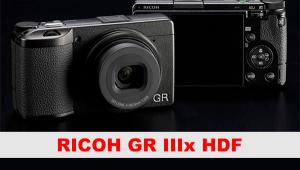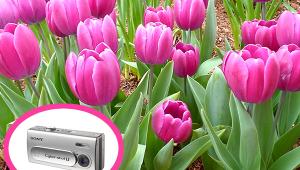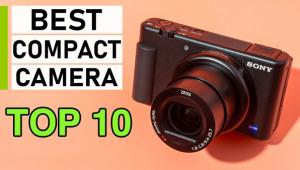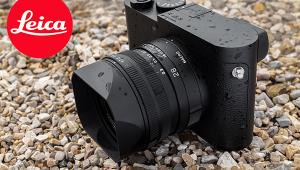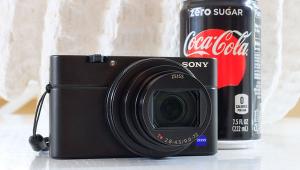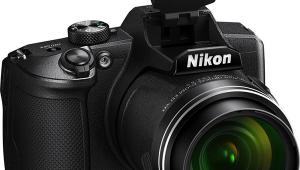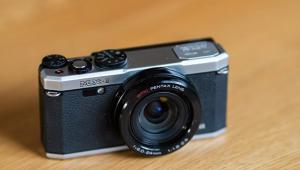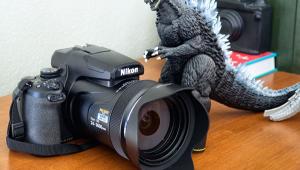Sony QX1 Lens-Style Camera Review
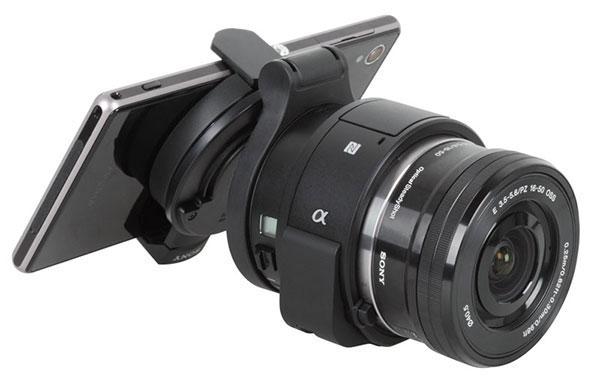
[Editor's Note: Lab test and comments are by Betternet, Shutterbug’s TIPA-affiliated testing lab. TIPA (www.tipa.com) is a worldwide association of photo and imaging magazine editors. Shutterbug is the sole US member of the association, and Editor at Large George Schaub serves as a member of the Technical Committee. Please click on the Image Tech tab on the home page for more camera review tests.]
In 2013, Sony introduced two extraordinary cameras – the QX10 and the QX100. Both were based on compact cameras (WX100 and RX100 II), but didn't have “camera bodies” and LCD screens. Instead, they consisted of a lens, image sensor, image processor and a storage media system, and both needed either a smartphone or tablet computer to serve as the “external camera.” The newest in the QX line is the QX1. The main camera concept is similar to the 2013 models, but the QX1 offers a large APS-C sensor with 20-megapixel resolution and an E mount for interchangeable lenses.
The camera has a very small body and it combines sensor, image processor, battery and storage media slot (micro SD or micro MemorySticks). It has a status LCD on its right hand side that only shows information on the battery and Wi-Fi status. All other information is shown on the smartphone monitor. On the left hand side there’s the shutter release button, but image or video recording can also be activated by the “virtual” shutter release button on the smartphone LCD. The on/off switch, the built-in pop-up flash and the flash lock button are located on the top side.
To establish a wireless connection between the smartphone and QX1 you can use WLAN settings on the smartphone, but it is much easier to use the NFC system. If the smartphone is NFC compatible, the photographer just has to touch the camera with his smartphone to establish connectivity. The camera control software is available for free for Android and iOS systems. Connecting the QX1 and the host via NFC automatically launches the software.




The software is similar to that found in the camera facet of a smartphone, but it also allows full access to additional QX1 features. For example, the photographer can use Raw mode and P, S and A exposure modes, although a manual mode is missing. The focus area and zoom, as well as EV compensation, can be changed via the touch screen. In all, camera control is as comfortable -- or as uncomfortable -- as cameras with total touch screen control. In our tests we used the standard kit lens with motor zoom, which offers a zoom switch on the left hand side of the lens body, which is really handy.
Working with the QX1 and a smartphone sometimes needs “a third hand,” especially if the photographer likes to hold both components separately instead of mounting the camera/lens body to the smartphone. Sony supplies the camera with a mounting clamp, which can be used for most standard-sized smartphones up to screen sizes of about 6 inches.

Comments on Image Quality
Color: The color reproduction in images created by the Sony QX1 is very good. The automatic white balance system worked nearly perfectly: The gray color samples of the GretagMacbeth chart are located nearly perfectly in the center of the result chart. However, the test box shot shows a little yellowish and greenish touch in the reproduction of the neutral gray background.
The red nuances are exaggerated and have a high yellow rate. This effect reduces the differentiation in red colored elements like the spool in the upper right of the standard test box shot. In contrast to that, the differentiation and saturation of blue nuances is very good. Skin tones are a bit “beautified” by a higher magenta rate, especially brighter skin tones. This is also noticeable in the standard test box shot.

Sharpness: The Sony QX1 reproduced the ISO 12233 test chart with 3078 of 3632 lines per picture height, which is an average result for a camera with APS-C sensor. The camera creates somewhat softer images than other cameras APS-C cameras we have tested and therefore showed only minor over- and undershot effects. We did notice some some clipping effects in our chart shots. The slightly softer character of the images is noticeable in both of the test shots.
Noise: The camera showed a very good performance in our noise tests. Luminance noise results are on the same level as the results of a good APS-C sensor camera. The QX1 keeps the luminance level far below 1.0 percent. In addition, it uses an intelligent anti-noise filtering, results in clean images at ISO 1600 and 3200 with only minor color noise artifacts. Noticeable noise artifacts become visible in images taken at 6400 and higher.
The dynamic range results of the QX1 are excellent. The camera achieved a maximum of 11.3 f-stops and keeps a high dynamic range level up to ISO 800 (more than 10 f-stops). In higher ISO speed settings the dynamic range drops significantly.

Comments on Video Functions and Handling
The camera records full HD video with 1920 x 1080 pixels. Videos are recorded with a maximum frame rate of 30 frames per second. The QX1 is able to record MP4 files and uses H.264 compression. The restriction to 30 frames and MP4 recording is a little unusual for a Sony camera. Most system Sony cameras (CSC) models of the NEX or Alpha series are able to record higher frame rates and offer more videos modes with different compression and file settings (with 50/60p in XAVC-S for example). The video recording modes of the QX1 correlate more to the standard video function of smartphones.
The camera doesn't offer manual exposure settings in video mode. The ISO setting is fixed to “AUTO” and the photographer can only use EV compensation to control exposure settings. Manual focusing is allowed, but manual sound level control is missing. The camera records sound with internal microphones: it doesn't offer an interface for an external microphone.

Comments on Video Quality
The camera showed a disappointing result in the video resolution tests. The full HD recording of the ISO 12233 showed a contrast line reproduction of 680 lines per picture height. Even though the QX1 created soft looking videos, some aliasing and moiré effects were noticeable in our tests.
Color reproduction is very good. Color error level is low: only red nuances are a little overdone. Skin tone reproduction is very good.
The camera doesn't allow manual exposure control and ISO speed settings, so our noise and dynamic range tests were done with one single shot in AUTO mode. The camera achieved only 6.56 f-stops, which is very low. The low result was caused by the very bright recording result of our test. Using AUTO mode and even a minus 3 EV stop compensation setting created overexposed results.
Pro:
+ Unique camera concept
+ Large sensor, very good image quality
+ Many different lens system are usable
Contra:
- Handling with camera module, smartphone and additional lens can be difficult
- Missing manual exposure settings
- Missing flash- or accessory shoe
- Extremely small status LCD
Lab tests and comments by Beterrnet, Shutterbug’s TIPA affiliated testing lab. Edited by George Schaub.
- Log in or register to post comments
